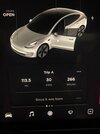This has been said/posted a lot of times by me. I guess some is about to get tired of seeing the same graph.

- The first years of a battery life, calendar aging is the very dominant part.
- The higher the average SOC when the car sleeps, the more degradation.
-Calendar aging lessens with time. After the first year degradation from time it will take another four years to reach the double degradation(from time), and to double again after five, twenty years will be needed.
-If the average SOC is high, specially with high ambient temperatures, the calendar aging can be as high as ten times(or more) than the cyclic aging.
- For the first three-five years or so, the mileage do not have a noticeble scientific impact on the degradation as the calendar aging might be 10% and the cyclic aging might be 1-2% or so.
If you look at this graph( taken from a research report), 9.6 months at 25C causes a capacity loss of about 5% for a SOC of 60% or more. This graph should be read as *The time my car spends at a given SOC*, or average SOC when the car isnt in use.
There’s a sharp step at 55 to 60% where calendar aging increases much. Staying below this literally cut the calendar aging in half( at least).
View attachment 738269
Theres one thing more that is good with low SOC: the lower a cycle is in the SOC range, the lower the cyclic aging is. From research we know that a small cycle around 70% causes
five times higher degradation than the same size of cycle at 30% (600 Full Equivalent Cycles) caused 10% degradation when cycled around 70% but only 2% when cycled around 30%. The battery can do five times more miles if cycled at low SOC than at high SOC. And still use the same size of the cycle, so the only thing changed is were in the SOC range it takes place.
This still counts for a quite small part of the total degradation so it isnt the main reason to stay at low SOC when possible.
I have found lithium battery technology interresting since 2006 or so, and have read research reports since and buting a Tesla didnt change this. I have followed my knowledge but
not that much that it makes the electric car ownership a PITA.
After 11 months and 29.000km my car still shows full range, and the BMS calculated battery capacity is 80.5kWh, which points to about 2% degradation(coming from 82.1kWh Full Size When New).
In my own precalculated degradation I would be at 2.5% by now. Despite this, I have Supercharged whenever needed( about 4000km or 14% is by SuC) and I have charged it full when needed.
Keeping the calendar aging low means it lessens much faster so I will probably sit with 4-5% total degradation after five years instead of maybe 10-20% if I had used high SOC.



